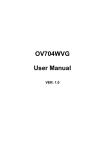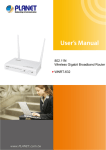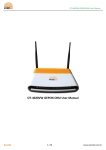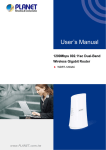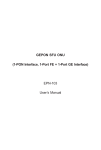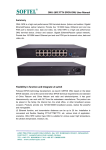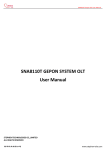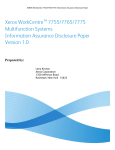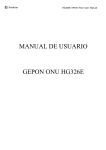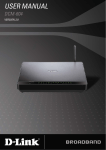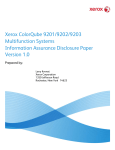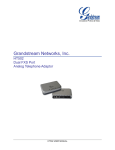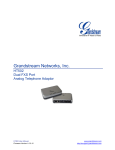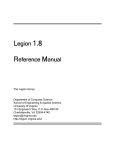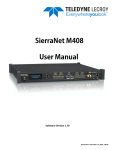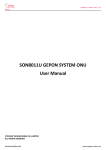Download User Manual
Transcript
Copyright
Copyright 2014 by PLANET Technology Corp. All rights reserved. No part of this publication may be
reproduced, transmitted, transcribed, stored in a retrieval system, or translated into any language or computer
language, in any form or by any means, electronic, mechanical, magnetic, optical, chemical, manual or
otherwise, without the prior written permission of PLANET.
PLANET makes no representations or warranties, either expressed or implied, with respect to the contents
hereof and specifically disclaims any warranties, merchantability or fitness for any particular purpose.
Any
software described in this manual is sold or licensed "as is". Should the programs prove defective following their
purchase, the buyer (and not this company, its distributor, or its dealer) assumes the entire cost of all necessary
servicing, repair, and any incidental or consequential damages resulting from any defect in the software. Further,
this company reserves the right to revise this publication and to make changes from time to time in the contents
hereof without obligation to notify any person of such revision or changes.
All brand and product names mentioned in this manual are trademarks and/or registered trademarks of their
respective holders.
Federal Communication Commission Interference Statement
This equipment has been tested and found to comply with the limits for a Class B digital device, pursuant to Part
15 of FCC Rules. These limits are designed to provide reasonable protection against harmful
interference in a residential installation. This equipment generates, uses, and can radiate radio
frequency energy and, if not installed and used in accordance with the instructions, may cause
harmful interference to radio communications. However, there is no guarantee that interference will not occur in
a particular installation. If this equipment does cause harmful interference to radio or television reception, which
can be determined by turning the equipment off and on, the user is encouraged to try to correct the interference
by one or more of the following measures:
1. Reorient or relocate the receiving antenna.
2. Increase the separation between the equipment and receiver.
3. Connect the equipment to an outlet on a circuit different from that to which the receiver is connected.
4. Consult the dealer or an experienced radio technician for help.
FCC Caution:
To assure continued compliance, for example, use only shielded interface cables when connecting to computer
or peripheral devices. Any changes or modifications not expressly approved by the party responsible for
compliance could void the user’s authority to operate the equipment.
This device complies with Part 15 of the FCC Rules. Operation is subject to the following two conditions:
(1) This device may not cause harmful interference.
(2) This device must accept any interference received, including interference that may cause undesired
operation.
I
Federal Communication Commission (FCC) Radiation Exposure Statement
This equipment complies with FCC radiation exposure set forth for an uncontrolled environment. In order to
avoid the possibility of exceeding the FCC radio frequency exposure limits, human proximity to the antenna
shall not be less than 20 cm (8 inches) during normal operation.
R&TTE Compliance Statement
This equipment complies with all the requirements of DIRECTIVE 1999/5/CE OF THE EUROPEAN
PARLIAMENT AND THE COUNCIL OF 9 March 1999 on radio equipment and telecommunication terminal
equipment and the mutual recognition of their conformity (R&TTE).
The R&TTE Directive repeals and replaces in the directive 98/13/EEC (Telecommunications Terminal
Equipment and Satellite Earth Station Equipment) as of April 8, 2000.
Safety
This equipment is designed with the utmost care for the safety of those who install and use it. However, special
attention must be paid to the dangers of electric shock and static electricity when working with electrical
equipment. All guidelines of this and of the computer manufacture must therefore be allowed at all times to
ensure the safe use of the equipment.
National Restrictions
This device is intended for home and office use in all EU countries (and other countries following the EU
directive 1999/5/EC) without any limitation except for the countries mentioned below:
Country
Restriction
Bulgaria
None
Reason/remarks
General authorization required for outdoor use and
public service
Military radio location use. Refarming of the 2.4 GHz
Outdoor use limited to 10
France
mW
e.i.r.p.
within
band has been ongoing in recent years to allow the
the
current relaxed regulation. Full implementation planned
2454-2483.5 MHz band
Italy
None
Luxembourg
None
Norway
Implemented
Russian
None
in 2012
If used outside of own premises, general authorization is
required
General authorization required for network and service
supply (not for spectrum)
This subsection does not apply for the geographical area
within a radius of 20 km from the centre of Ny-Ålesund
Only for indoor applications
Federation
Note: Please don’t use the product outdoors in France.
WEEE Regulations
To avoid the potential effects on the environment and human health as a result of the presence of
hazardous substances in electrical and electronic equipment, end users of electrical and electronic
equipment should understand the meaning of the crossed-out wheeled bin symbol. Do not dispose of
WEEE as unsorted municipal waste and have to collect such WEEE separately.
II
Revision
User Manual of PLANET GEPON Wi-Fi ONU
Model: EPN-402NV
Rev: 1.0 (Oct., 2014)
Part No. EM-EPN-402NV_v1.0 (2081-BA0110-000)
III
CONTENTS
Chapter 1.
Product Introduction ..................................................................................... 1
1.1
Package Contents ...............................................................................................................1
1.2
Product Description............................................................................................................2
1.3
Product Features................................................................................................................. 5
1.4
Product Specifications .......................................................................................................6
Chapter 2.
2.1
Hardware Installation .................................................................................... 8
Hardware Description .........................................................................................................8
2.1.1
Front Panel .............................................................................................................10
2.1.2
Rear Panel.............................................................................................................. 11
2.1.3
Side Panel ..............................................................................................................12
2.1.4
Bottom Side ............................................................................................................13
Chapter 3.
Connecting to the Wi-Fi ONU ..................................................................... 14
3.1
System Requirements ......................................................................................................14
3.2
Installing the Wi-Fi ONU ...................................................................................................14
Chapter 4.
4.1
4.2
Manual Network Setup - TCP/IP Configuration ..............................................................16
4.1.1
Obtaining an IP Address Automatically...................................................................16
4.1.2
Configuring the IP Address Manually .....................................................................19
Starting Setup in the Web UI ............................................................................................23
Chapter 5.
5.1
5.2
5.3
Quick Installation Guide ............................................................................. 16
Configuring the Wi-Fi ONU ......................................................................... 24
STATUS ..............................................................................................................................24
5.1.1
Device Info..............................................................................................................24
5.1.2
WAN Info.................................................................................................................24
5.1.3
Userside Info...........................................................................................................26
5.1.4
VoIP Info .................................................................................................................28
5.1.5
Remote Management .............................................................................................28
NETWORK..........................................................................................................................29
5.2.1
WAN Setup .............................................................................................................29
5.2.2
Banding Setup ........................................................................................................30
5.2.3
LAN Setup ..............................................................................................................30
5.2.4
WLAN Setup ...........................................................................................................32
5.2.5
Remote Management .............................................................................................39
5.2.6
QoS.........................................................................................................................41
5.2.7
SNTP ......................................................................................................................47
5.2.8
Route Setup............................................................................................................48
SECURITY ..........................................................................................................................52
IV
5.4
5.5
5.6
5.7
5.3.1
WAN Access Setup.................................................................................................52
5.3.2
Firewall....................................................................................................................53
5.3.3
MAC Filter...............................................................................................................53
5.3.4
IP Filter....................................................................................................................54
APPLICATION ....................................................................................................................57
5.4.1
DDNS Setup ...........................................................................................................57
5.4.2
Advanced NAT ........................................................................................................58
5.4.3
UPnP Setup ............................................................................................................61
5.4.4
VoIP ........................................................................................................................61
5.4.5
IGMP.......................................................................................................................74
5.4.6
MLD Setup..............................................................................................................75
5.4.7
Daily Application .....................................................................................................75
MANAGEMENT ..................................................................................................................78
5.5.1
User Management ..................................................................................................78
5.5.2
Device Management...............................................................................................78
5.5.3
Log Management....................................................................................................79
DIAGNOSIS ........................................................................................................................82
5.6.1
Line Diagnosis ........................................................................................................82
5.6.2
Ping Test .................................................................................................................82
5.6.3
Tracert Diagnosis....................................................................................................83
5.6.4
Inform Manual.........................................................................................................83
HELP...................................................................................................................................84
Chapter 6.
Quick Connection to a Wireless Network ................................................. 85
6.1
Windows XP (Wireless Zero Configuration)...................................................................85
6.2
Windows 7 (WLAN AutoConfig).......................................................................................87
6.3
Mac OS X 10.x....................................................................................................................89
6.4
iPhone / iPod Touch / iPad ...............................................................................................91
Appendix A: Specifications................................................................................................ 94
Appendix B: Glossary ........................................................................................................ 96
V
User Manual of EPN-402NV
Chapter 1. Product Introduction
1.1 Package Contents
Thank you for choosing PLANET EPN-402NV. Before installing the ONU, please verify the contents inside the
package box.
EPN-402NV
Quick Installation Guide
Power Adapter
Ethernet Cable
RJ45 Cable
12V DC, 1A
100~240V AC
If there is any item missing or damaged, please contact the seller immediately.
-1-
User Manual of EPN-402NV
1.2 Product Description
Perfectly Designed for Fiber to the Home Applications
PLANET EPN-402NV is a fiber to the home (FTTH) broadband access equipment type. With built-in 1.25Gbps
GEPON fiber interface, the EPN-402NV supports different optic types for WAN and the distance can be up to
20km through the fiber connection. It can handle multiple high-throughput services such as IPTV, on-line
gaming, VoIP and Internet access, and keep the bandwidth usage smoothly via its QoS features. Thus, with the
advantages of high reliability and scalability, the EPN-402NV can further be applied in the network of SOHO
(small office or home office) or small businesses that provide high-performance access services.
Cost-effective Network Connection Solution
With the growing network services such as HDTV, IPTV, voice over IP (VoIP) and multimedia broadband
applications, the demand for broadband use has increased tremendously. The Passive Optical Network (PON)
is the most promising NGN (Next Generation Networking) technology. As compared to other broadband access
technologies such as xDSL and cable modem, the Passive Optical Network (PON) technology offers some
competitive advantages, including a long-term life expectancy of the fiber infrastructure, lower operating costs
through the reduction of “active” components, support up to 20km distance between equipment nodes, and most
importantly, provide much greater bandwidth.
-2-
User Manual of EPN-402NV
Flexibility and Extension solution
PLANET EPN-402NV provides ultra high-speed Internet connection with PLANET OLT (EPL-2000) via the new
GEPON technology. The upstream and downstream transmission speed provided is up to 1.25Gbps and its
maximum distance can be 20km. Through the PON technology, the EPN-402NV can receive and deliver
high-speed voice, data and video services. It offers competitive advantages including a long-term life expectancy
of the fiber infrastructure, lower operating costs from the reduction of “active” components, easy Installation and
maintenance, and most importantly, offering a much greater and more stable bandwidth. The EPN-402NV is the
perfect solution working with PLANET OLT EPL-2000 to offer benefits of cost-effectiveness, scalability and
flexibility to network deployment.
High-speed 802.11n Wireless Type
With built-in IEEE 802.11b/g and 802.11n wireless network capabilities, the EPN-402NV allows any computer
and wireless-enabled network device to connect to it without additional cabling. 802.11n wireless capability
brings users the speed of wireless data transmission rate to as high as 300Mbps. The radio coverage is also
doubled to offer strong wireless connection even in widely spacious offices or houses.
Standard Compliance with FXS Port
The EPN-402NV provides two FXS ports that can easily integrate with general voice over IP system. The
EPN-402NV makes it simple for the enterprise featuring voice and data system or expanding voice system to
new locations. It helps you to save money on long-distance calls; for example, the remote users can dial in
-3-
User Manual of EPN-402NV
through a Unified VoIP Communication System just like an extension call but no long-distance call charge would
occur.
Robust ONU Management
The EPN-402NV is designed to work with PLANET OLT EPL-2000 to provide robust FTTx applications. With the
Element Management System (EMS) built in the EPL-2000, the administrators can manage and configure the
facilities such as adding or removing PLANET OLTs and ONUs to or from the network architecture easily and
economically. The EMS also supports many operating and monitoring functions for efficient ONU management
including ONU auto-detection, auto-registration, testing link connection, binding MAC address, loopback test
and filtration, bandwidth control, flow control, and multicast stream control.
-4-
User Manual of EPN-402NV
1.3 Product Features
GEPON
Supports 802.3ah CTC external OAM
1 x SC type GEPON port
Up to 1.25Gbps upstream and downstream
Up to 20km
Supports 128-bit triple churning algorithm
Supports dying gasp
Ethernet
Supports 802.1Q VLAN, QoS
Supports broadcast storm protection
Supports bandwidth control
Supports IGMP snooping/proxy
Supports IPv4/IPv6
VoIP
Supports G.711 a/u law, G.712, G.729a code/decode
Supports VAD, CNG
Supports G.711/T.38 fax
Supports SIP/H.248/MGCP
Wireless
Up to 300Mbps bandwidth
Compatible with 802.11b/g/n
Compatible with equipment working on 2.4G Hz
Supports WPS
Physical Hardware
4 x 10/100Mbps Fast Ethernet port
2 x FXS port
1 x Reset Button
1 x Power Connector
Features
Dynamic Bandwidth Allocation (DBA) support
IEEE 802.3ah compliant Forward Error Correction (FEC)
Enhanced IGMP feature
1.5MB of integrated packet buffering
Supports Layer-2/3/4 classification rules
Supports IEEE 802.3x flow control
Internal Management Information Base (MIB) counters for network statistics
-5-
User Manual of EPN-402NV
1.4 Product Specifications
EPN-402NV
Product
GEPON Wi-Fi ONU
Hardware Specifications
Transmission Speed
Port
Downstream: 1.25 Gbps
Upstream: 1.25 Gbps
PON Port
1 x PON Port
Ethernet Port
4 x RJ45 (10/100Base-TX)
FXS Port
2 x RJ11 Port
USB Port
1 x USB 2.0 Port Type A, 5V 500mA
Optic Wavelength
TX:1310mm
RX:1480mm
Optical Receive Sensitivity
-25 dBm
Dimensions (W x D x H)
190 x 137 x 48 mm
Weight
350g
Power Input
12V DC, 1A
Power Consumption
12W
EMS Utility Specifications
Supports IGMP Snooping
Supports MLD Snooping
Supports 802.3ah CTC external OAM
ONU Feature
Supports DBA algorithm
Supports 128-bit triple churning algorithm
Supports dying gasp IEEE 802.3ah compliant forward error
Correction (FEC)
Supports TR-069
Wireless Interface Specifications
Standard
Frequency Band
Compliant with IEEE 802.11b/g/n
2.4~2.4835GHz
Antenna
Gain: 3 dBi internal antennas
Extended Frequency
DSSS
DBPSK, DQPSK, QPSK, CCK and OFDM (BPSK/QPSK/16-QAM/
64-QAM)
Modulation Type
Data Transmission Rates
802.11n (40MHz):270/243/216/162/108/81/54/27Mbps
135/121.5/108/81/54/40.5/27/13.5Mbps (Dynamic)
802.11n (20MHz):130/117/104/78/52/39/26/13Mbps
65/58.5/52/39/26/19.5/13/6.5Mbps (Dynamic)
802.11g:54/48/36/24/18/12/9/6Mbps (Dynamic)
802.11b:11/5.5/2/1Mbps (Dynamic)
Channel
Europe/ ETSI: 2.412~2.472GHz (13 Channels)
Max. RF Power
16 dBm max. (EIRP)
WEP (64/128-bit) encryption security
WPA-Personal / WPA2-Personal (TKIP/AES)
Mixed WPA / WPA2-PSK
Encryption Security
-6-
User Manual of EPN-402NV
Provides wireless LAN ACL (Access Control List) filtering
Wireless Security
Wireless Advanced
Max. Supported Clients
Firewall
Wireless URL filtering
Supports WPS (Wi-Fi Protected Setup)
Enables/Disables SSID broadcast
WMM (Wi-Fi multimedia): 802.11e wireless QoS
Provides wireless statistics
128
NAT firewall with SPI (Stateful Packet Inspection)
Built-in NAT server supporting DMZ
Built-in firewall with IMAC address/ port/ URL filtering
Supports DoS protection
VoIP Protocols and Standard
Standard
Voice Codec
Voice Standard
SIP/H.248/MGCP
T.38 (G.711 fax pass-through)
G.711 a/u law, G.712, G.729a code/decode
VAD (Voice Activity Detection)
CNG (Comfort Noise Generation)
Environment Specifications
Temperature
Operating temperature: -5 ~ 55 degrees C
Storage temperature: -30 ~ 60 degrees C
Humidity
Operating Humidity: 10 ~ 90% non-condensing
Storage Humidity: 5 ~ 95% non-condensing
Standards Conformance
Standards Compliance
IEEE 802.3 10BASE-T
IEEE 802.3u 100BASE-TX
IEEE 802.3x flow control and back pressure
IEEE 802.11n
-7-
User Manual of EPN-402NV
Chapter 2. Hardware Installation
Please follow the instructions below to connect the EPN-402NV to the existing network devices and your computers.
2.1 Hardware Description
Dimensions: 190x 137 x 48mm (L x W x H)
Diagram :
Figure 2-1
Figure 2-2
-8-
User Manual of EPN-402NV
Figure 2-3
Figure 2-4
-9-
User Manual of EPN-402NV
2.1.1 Front Panel
The front panel provides a simple interface monitoring the ONU. Figure 2-5, 2-6 shows the front panel of the
EPN-402NV.
Front Panel
Figure 2-5 SC Type GEPON
Figure 2-6 EPN-402NV Front Panel
LED
(Left to Right)
PWR
PON
LOS
INT
WLAN
FXS1 / FXS2
ETH1/iTV
COLOR
Green
Green
Red
Green
Green
Green
Green
STATE
FUNCTION
On
Device power on
Off
Device power off
On
MPCP and OAM be active
Flash
Registering
Off
MPCP and OAM not founded
Flash
Optical Power too Low
Off
Optical Power normal
On
In ONU mode, Internet is connected, no data transmission
Flash
Connected, no data transmission
Off
Data is transmitting
On
WLAN is active
Flash
Data is transmitting
Off
System power off or WLAN is forbidden
On
Registered successfully to server
Flash
Data is transmitting
Off
Registered unsuccessfully
On
Linked
-10-
User Manual of EPN-402NV
ETH3 / ETH4
WPS
Green
USB
Green
Flash
Data is transmitting
Off
No link
On
Linked successfully
Flash
Negotiating
Off
Linked unsuccessfully
On
Linked and in master mode
Flash
Data is transmitting
Off
No link
2.1.2 Rear Panel
Rear Panel
Figure 2-7 EPN-402NV Rear Panel
Object
FXS1 FXS2
Description
RJ11 FXS Connecter, connected to telephone or fax.
Supply Voice Service
ETH1
ETH3
Connected to Local Area Network.
ETH4
iTV
iTV Port can be connected to IPTV BOX
WPS
Press WPS Button, start to negotiate for WPS.
WLAN
Switch to open or close WLAN function.
Reset Button
Press this button and hold for 1 second for the equipment to be defaulted.
USB
USB 2.0 host port.
-11-
User Manual of EPN-402NV
12V DC
Power input port.
Power
Power switch.
2.1.3 Side Panel
Figure 2-8 EPN-402NV Side Panel
Port Type
Function
Indicator LED turn on/off
Press down to turn LED on; pop up to turn LED off.
-12-
User Manual of EPN-402NV
2.1.4 Bottom Side
Figure 2-8 EPN-402NV Bottom Side
-13-
User Manual of EPN-402NV
Chapter 3. Connecting to the Wi-Fi ONU
3.1 System Requirements
Broadband Internet Access Service (Passive Optical Network connection)
PCs with a working Ethernet Adapter and an Ethernet cable with RJ45 connectors
PC subscribers use Windows 98/ME, NT4.0, 2000/XP, Windows Vista / Win 7, MAC OS 9 or later, or
Linux, UNIX or other platforms compatible with TCP/IP protocols
The above PC is installed with a Web browser
1. The GEPON in the following instructions means PLANET EPN-402NV.
2. It is recommended to use Internet Explore 7.0 or above to access the Wi-Fi ONU.
3.2 Installing the Wi-Fi ONU
Before installing the Wi-Fi ONU, make sure your PC is connected to the Internet through the broadband service
successfully at this moment. If there is any problem, please contact your local ISP. After that, please install the
Wi-Fi ONU according to the following steps. Don't forget to pull out the power plug and keep your hands dry.
Step 1. Power off your PC and PLANET EPN-402NV.
Step 2. Locate an optimum location for the EPN-402NV. The best place is usually at the center of your wireless
network.
Step 3. Connect the Passive Optical Network to the SC Port of the EPN-402NV with fiber cable, shown in
Figure 3-1.
-14-
User Manual of EPN-402NV
Figure 3-1
Step 4. Please fix the fiber cable on the bottom of the EPN-402NV as shown in Figure 3-2.
Figure 3-2
-15-
User Manual of EPN-402NV
Chapter 4. Quick Installation Guide
This chapter will show you how to configure the basic functions of your Wi-Fi ONU.
A computer with wired Ethernet connection to the Wi-Fi ONU is required for the first-time
configuration.
4.1 Manual Network Setup - TCP/IP Configuration
The default IP address of the Wi-Fi ONU is 192.168.1.1 and the default Subnet Mask is 255.255.255.0. These
values can be changed as you desire in the web UI of the Wi-Fi ONU. In this section, we use all the default
values for description.
Whether the Wi-Fi ONU is configured via wired or wireless connection, the PC needs to be assigned an IP
address first. Before you connect the local PC to the Wi-Fi ONU via wired or wireless connection, please
configure the IP address for your PC in the following two ways first.
Obtaining an IP address automatically
Configuring the IP address manually
In the following sections, we’ll introduce how to install and configure the TCP/IP correctly in Windows 7. And the
procedures in other operating systems are similar. First, make sure your Ethernet Adapter is working, and refer
to the Ethernet adapter’s manual if needed.
4.1.1 Obtaining an IP Address Automatically
Summary:
1.
Set up the TCP/IP Protocol in "Obtain an IP address automatically" mode on your PC.
2.
Then the Wi-Fi ONU built-in DHCP server will assign IP address to the PC automatically.
If you are sure the DHCP server of Wi-Fi ONU is enabled (the default setting of ONU Mode), you can set up the
TCP/IP Protocol in "Obtain an IP address automatically" mode on your PC. And then the Wi-Fi ONU built-in
DHCP server will assign an IP address to the PC automatically.
1.
Installing TCP/IP Component
1) On the Windows taskbar, click the Start button, point to Control Panel and then click it.
2) Under the Network and Internet icon, click on the View network status and tasks. And then click
-16-
User Manual of EPN-402NV
Change adapter settings.
Figure 4-1 Change Adapter Settings
3) Right-click on the Wireless Network Connection and select Properties in the appearing window.
Figure 4-2 Network Connection Properties
-17-
User Manual of EPN-402NV
4) In the prompt window shown below, double-click on the Internet Protocol Version 4 (TCP/IPv4).
Figure 4-3 TCP/IP Setting
5) Choose Obtain an IP address automatically, and Obtain DNS server address automatically as
shown in the figure below. Then click OK to save your settings.
-18-
User Manual of EPN-402NV
Figure 4-4 Obtain an IP Address Automatically
4.1.2 Configuring the IP Address Manually
Summary:
Set up the TCP/IP Protocol for your PC.
Configure the network parameters. The IP address is 192.168.1.xxx ("xxx" is any number from 2 to
254), Subnet Mask is 255.255.255.0, and Gateway is 192.168.1.1 (The ONU's default IP address)
If you are sure the DHCP server of WiFi ONU is disabled, you can configure the IP address manually. The IP
address of your PC should be 192.168.1.xxx (the same subnet of the IP address of the Wi-Fi ONU, and "xxx" is
any number from 2 to 254), Subnet Mask is 255.255.255.0, and the Gateway is 192.168.1.1 (The default IP
address of the Wi-Fi ONU)
1) Continue the settings from the last figure. Select Use the following IP address radio button.
2) If the LAN IP address of the Wi-Fi ONU is 192.168.1.1, enter IP address 192.168.1.x (x is from 2 to 254),
and Subnet mask 255.255.255.0.
3) Enter the LAN IP address of the Wi-Fi ONU (the default IP is 192.168.1.1) into the default gateway field.
4) Select Use the following DNS server addresses radio button. In the preferred DNS Server field, you can
enter the DNS server IP address provided by your local ISP. Then click OK to save your settings.
-19-
User Manual of EPN-402NV
Figure 4-5 IP and DNS Server Addresses
Now, you can run the ping command in the command prompt to verify the network connection between your
PC and the ONU. The following example is in Windows 7 OS. Please follow the steps below:
1.
Click on Start
2.
Type “cmd” in the Search box.
Figure 4-6
3.
Open a command prompt, and type ping 192.168.1.1, and then press Enter.
-20-
User Manual of EPN-402NV
If the result displayed is similar to Figure 4-7, it means the connection between your PC and the ONU
has been established well.
Figure 4-7 Successful Ping Command
If the result displayed is similar to Figure 4-8, it means the connection between your PC and the ONU
has failed.
Figure 4-8 Failed Ping Command
If the address is 0.0.0.0, check your adapter installation, security settings, and the settings on your ONU. Some
firewall software programs may block a DHCP request on newly installed adapters.
-21-
User Manual of EPN-402NV
If the ONU's IP address is 192.168.1.1, your PC's IP address must be within the
range of 192.168.1.2 ~ 192.168.1.254.
-22-
User Manual of EPN-402NV
4.2 Starting Setup in the Web UI
It is easy to configure and manage the EPN-402NV with the web browser.
Step 1.
To access the configuration utility, open a web-browser and enter the default IP address
http://192.168.1.1 in the web address field of the browser.
Figure 4-9 Login the ONU
After a moment, a login window will appear. Enter admin for the User Name and Password, both in lower case
letters. Then click the OK button or press the Enter key.
Figure 4-10 Login Window
Default IP Address: 192.168.1.1
Default User Name: admin
Default Password: admin
If the above screen does not pop up, it may mean that your web browser has been set to a
proxy. Go to Tools menu>Internet Options>Connections>LAN Settings in the screen that
appears, cancel the Using Proxy checkbox, and click OK to finish it.
-23-
User Manual of EPN-402NV
Chapter 5. Configuring the Wi-Fi ONU
This chapter delivers a detailed presentation of ONU’s functions and features.
Figure 5-1 Wi-Fi ONU Functions
5.1 STATUS
5.1.1 Device Info
On this page, you can view information about the current running status of the EPN-402NV, including device
identifier, hardware version, software version and PON status.
Figure 5-1-1 Device Info
The page includes the following information:
Object
Description
Device Type
The Wi-Fi ONU model.
Software Version
PON Status
This is the current software the Wi-Fi ONU is using. This will change
if you upgrade your ONU.
The current mode in use.
5.1.2 WAN Info
This page shows the status of your WAN network.
-24-
User Manual of EPN-402NV
Figure 5-1-2 WAN Info
-25-
User Manual of EPN-402NV
Figure 5-1-3 EPON information
5.1.3 Userside Info
This page shows the status of your WLAN, LAN and USB.
-26-
User Manual of EPN-402NV
Figure 5-1-4 WLAN information
Figure 5-1-5 LAN information
Figure 5-1-6 USB information
-27-
User Manual of EPN-402NV
5.1.4 VoIP Info
This page shows the status of your VoIP.
Figure 5-1-7 VoIP status
Figure 5-1-8 Phone status
5.1.5 Remote Management
This page shows the status of your WAN connection.
Figure 5-1-9 Connection
Figure 5-1-10 Configuration
-28-
User Manual of EPN-402NV
5.2 NETWORK
5.2.1 WAN Setup
This page displays the information of the WAN interface for you to set up.
Figure 5-2-1 WAN Setup
The page includes the following fields:
Object
Description
Connection Name
The default setting is TR-069. You can add a new WAN connection.
Mode
Select Bridge or Route.
Link Mode
Select IPv4, IPv6 or IPv4/ v6.
Select this option to let ONU obtain IP settings automatically from
DHCP
your ISP, if your ISP does not give you any IP information or
account information. You don’t need to configure any settings for
this connection.
-29-
User Manual of EPN-402NV
If your ISP offers you static IP Internet connection type, select
Static
“Static IP" from corresponding drop-down menu and then enter IP
address, subnet mask, primary DNS and secondary DNS
information provided by your ISP in the corresponding fields.
PPPoE
Select PPPoE, if your ISP is using a PPPoE connection and provide
you with PPPoE user name and password info.
MTU
The maximum transmission unit. You can keep it as default.
VLAN
Enable or disable VLAN function.
VLAN ID
Enter the VLAN ID from 1 to 4094.
802.1p
Select the priority levels.
Service mode
Select a different kind of service.
5.2.2 Banding Setup
This page displays the information of the Banding Setup. You can enable or disable the function.
Figure 5-2-2 Banding Setup
5.2.3 LAN Setup
This page displays LAN information.
-30-
User Manual of EPN-402NV
Figure 5-2-3 IPv4 Setup
-31-
User Manual of EPN-402NV
Figure 5-2-4 IPv6 Setup
5.2.4 WLAN Setup
On the coming page, you can configure the basic wireless parameters.
-32-
User Manual of EPN-402NV
Figure 5-2-5 WLAN Setup
Object
Description
Enable Wi-Fi
You may choose to enable or disable wireless function.
You may choose to enable or disable SSID broadcast. When it is enabled,
Hide AP
the ONU SSID will be broadcast in the wireless network, so that it can be
scanned by wireless clients and they can join the wireless network with
this SSID.
Wireless Client
Isolation
Enable or disable wireless Isolation function
Disable WMM
After enabling this option, the transmission performance of the voice and
Broadcast
video data can be improved.
Enable WMF
After enabling this option, the transmission quality of video service such as
IPTV can be improved.
Set a name (SSID) for your wireless network -- the ID of the wireless
SSID
network. User can access the wireless network through it only. However,
if you switch to Client Mode, this field becomes the SSID of the AP you
-33-
User Manual of EPN-402NV
want to connect with.
Default: EPN-402NV
BSSID
Display the MAC address of the wireless interface.
For an optimal wireless performance, you may select the least
Channel Select
interferential channel. It is advisable that you select an unused channel or
“Auto” to let device detect and select the best possible channel for your
wireless network to operate on from the drop-down list.
802.11n/EWC
Select or disable this function.
Select a proper channel bandwidth to enhance wireless performance.
Bandwidth
When there are 11b/g and 11n wireless clients, please select the 802.11n
mode of 20/40M frequency band.
If you select 20MHz in both Bands or 20MHz in 2.4G Band and 40MHz in
5G Band, the service of control sideband does not work. When you select
Sideband Signal
40MHz in both Bands as the bandwidth, the following page appears. Then
you can select Lower or Upper as the value of sideband. As the control
sideband, when you select Lower, the channel is 1~7. When you select
Upper, the channel is 5~11.
Select the transmission rate for the network. The rate of data
transmission should be set depending on the speed of your wireless
network. You can select from a range of transmission speeds, or you
802.11n Rate
can select Auto to have the ONU automatically use the fastest possible
data rate and enable the Auto-Fallback feature. Auto-Fallback will
negotiate the best possible connection speed between the ONU and a
wireless client. The default value is Auto.
802.11n Protection
Mode
802.11n Client
Support Only
54g Rate
Muti Rate
The 802.11n standards provide a protection method so 802.11b/g and
802.11n devices can co-exist in the same network without “speaking” at
the same time.
Only stations that are configured in 802.11n mode can associate.
This enables Broadcom 54G Wireless Chipset to be more compatible with
other IEEE802.11b, IEEE802.11g based devices.
To set the wireless transmission power for multicast applications
Broadcom's standards-based frame-bursting technology is to improve
XPress™ Technology
802.11 wireless LAN performance. If the WMM (Quality of Service) is
enabled, the XPress™ Technology option can also be enabled.
TX Power
To set the Wireless Transmission power for the wireless router.
WMM(Wi-Fi Media)
To enable Wi-Fi Multimedia.
-34-
User Manual of EPN-402NV
WMM QoS
Enable or disable QoS features.
WMM APSD
To enable the Power Saving mode in Wi-Fi Multimedia.
Click “Advanced” to configure wireless security policies.
Figure 5-2-6 WLAN Security Setup
Object
Description
SSID
To choose the appropriate SSID that you configured.
Select the security mode from the dropdown list. There are 5
options in the Security Mode dropdown list:
Authentication Mode
OPEN
SHARE
WPA-PSK
WPA2-PSK
Mixed WPA2/WPA-PSK
Open Mode
-35-
User Manual of EPN-402NV
Figure 5-2-7 WLAN Security OPEN mode
Object
Description
SSID
Select an SSID for configuring the security settings.
Authentication Mode
Select the Open mode.
Enable or disable WEP encryption. After enabling this function, you
WEP Encryption
can set the encryption strength, current network key, and network
keys.
Key Length
You can set 64-bit or 128-bit key.
Current Key Index
The current key that you use.
Set the network key. If it is 128-bit key, you need to enter 13 ASCII
Key1/2/3/4
characters or 26 hexadecimal digits. For the 64-bit key, you need to
enter 5 ASCII characters or 10 hexadecimal digits.
Shared Mode
-36-
User Manual of EPN-402NV
Figure 5-2-8 WLAN Security Shared Mode
For the parameters’ description of shared mode, please refer to the Open Mode.
WPA Mode
Figure 5-2-9 WLAN Security WPA Mode
Object
Description
Select SSID
Select an SSID for configuring the security settings.
-37-
User Manual of EPN-402NV
Authentication
Mode
Select the WPA-PSK mode.
WPA Pre-share
The key for WPA encryption. Click the “Click Here to display” button
Key
to display the current key. The default key is 12345678.
WPA Refresh
Session key
Setting the interval for refresh session key.
Interval
WPA Encryption
You may select AES, or TKIP+AES.
WPA2 Mode
Figure 5-2-10 WLAN Security WPA2 Mode
For the parameters’ description of WPA2 mode, please refer to the WPA Mode.
Mixed WPA2/WPA-PSK Mode
-38-
User Manual of EPN-402NV
Figure 5-2-11 WLAN Security WPA2/WPA-PSK Mode
For the parameters’ description of WPA2/WPA-PSK mode, please refer to the WPA Mode.
5.2.5 Remote Management
On the coming page, you can configure the parameters for remote management of the ONU through TR069.
TR069
-39-
User Manual of EPN-402NV
Figure 5-2-12 TR069
The page includes the following fields:
Object
Description
Inform
To Enable or Disable TR069
Safety Connection
To import the license for the ITMS Server
Inform Interval
The time interval to send a notification (seconds)
ACS URL
The TR069 ACS Server address
ACS username
The User Name for the Remote Management Server
ACS password
The password for the associated User Name
Connection requests
To enable or disable User Authentication for the Remote
user authentication
Management Server
Request username
The Authentication ID for the Remote Management Server
Request password
The password for the Authentication ID
-40-
User Manual of EPN-402NV
To enable or disable the middleware
Middleware
Enabled (including TR069): To enable middleware with TR069
functionalities
Disabled: Check the box to disable middleware
Disabled (excluding TR069): To enable middleware without
TR069 functionalities
Middleware Address
The remote server address for the Middleware
Middleware Port
To set the port number for the Middleware server
OLT AUTH
To authorize the GEPON OLT with LOID, this function can prevent your Internet connection from being illegally
connected by other unknown users. It is available only if your GEPON OLT supports LOID authorization.
Figure 5-2-13 OLT AUTH
The page includes the following fields:
Object
Description
LOID
The Authorization LOID (The length must be within 24 digits)
Password
The password for the associated LOID
5.2.6 QoS
QoS
-41-
User Manual of EPN-402NV
Figure 5-2-14 QoS
The page includes the following fields:
Object
Description
To choose the available templates or to customize the
template to determine what services to enable the QoS for.
Internet, TR069 – To enable QoS for Internet Data and TR069
service
QoS Templates
Internet, TR069, VoIP – To enable QoS for Internet Data,
TR069 and VoIP services
Internet, TR069, IPTV – To enable QoS for Internet Data,
TR069 and IPTV services
Internet, TR069, VoIP, IPTV – To enable QoS for Internet
Data, TR069, VoIP and IPTV services
Manual templates – To customize the template to determine
the services to enable QoS
Enable QoS
Check the box to enable QoS
-42-
User Manual of EPN-402NV
Upstream Bandwidth
Scheduling Policy
Enable DSCP Flag
To set the uploading bandwidth for the customized QoS template
To determine the alternative QoS mode. You can choose to use
QoS PQ, QoS WRR or QoS CAR mode.
To enable the DSCP (Differentiated Services Code Point) flag for
QoS
Enable TC Flag
To enable the TC (Traffic Categories) flag for QoS
Enable 802.1_P Flag
To enable IEEE802.1P flag for QoS
Q1
To enable the highest QoS level
Q2
To enable a high QoS level
Q3
To enable a medium QoS level
Q4
To enable a low QoS level
Figure 5-2-14 QoS
-43-
User Manual of EPN-402NV
Figure 5-2-15 QoS
The page includes the following fields:
Object
Name
Description
The Service Name that you want to enable QoS for, e.g, VoIP,
TR069
Queue
The QoS queue for the service specified
Delete
Remove the service from the QoS template
Edit
To edit the service that you want to enable for QoS
Add
Delete
Server Name
Mark Queue
Click this button to edit Service Classification and edit Flow
Classification.
Click this button to delete the configured QoS service and flow
classification template
The service that you want to enable QoS for; you can set either
VoIP or TR069 service
The QOS level that you want to enable for the configured service
-44-
User Manual of EPN-402NV
Figure 5-2-16 QoS
The page includes the following fields:
Object
Name
Description
The Service Name that you want to enable QoS for, e.g, VoIP,
TR069
Queue
The QoS queue for the service specified
Delete
Remove the service from the QoS template
Edit
To edit the service that you want to enable for QoS
Add
Delete
Server Name
Mark Queue
Click this button to edit Service Classification and edit Flow
Classification.
Click this button to delete the configured QoS service and flow
classification template
The service that you want to enable QoS for; you can set either
VoIP or TR069 service
The QoS level that you want to enable for the configured service
-45-
User Manual of EPN-402NV
Figure 5-2-17 QoS
The page includes the following fields:
Object
Description
To set the priority for the flow classification that you enabled.
Queue
Group ID
1 is the highest QoS level
2 is the high QoS level
3 is the medium QoS level
4 is the low QoS level
To set the IPV4 or IPV6 version for the flow classification.
To set a different service or interface for flow classification
SMAC: To set flow classification for SMAC service
DMAC: To set flow classification for DMAC Service
802.1P: To set based flow classification for IEEE802.1P
service
Classify Type
Min Value
DIP: To set flow classification for DIP service
SPORT: To set flow classification for SPORT service
DPORT: To set flow classification for DPORT service
TOS: To set flow classification for TOS service
DSCP: To set flow classification for DSCP service
WAN Interface: To set flow classification for WAN interface
LAN Interface: To set flow classification for LAN interface
The minimum QoS level for the enabled Service
-46-
User Manual of EPN-402NV
Max Value
The maximum QoS level for the enabled Service
Protocol Type
To determine which protocol to enable QoS
FLOW CACHE
Figure 5-2-18 Flow Cache
The page includes the following fields:
Object
Enable Flow Cache
Description
Check the box for ‘Enable Flowcache’ to enable Cache for the
transmission flow
5.2.7 SNTP
Figure 5-2-19 SNTP
-47-
User Manual of EPN-402NV
Figure 5-2-20 SNTP
The page includes the following fields:
Object
Description
Auto Syn to NTP
Check the box to automatically sync with the available NTP time
Servers
servers
Connection Mode
To determine the way to connect to NTP servers.
Time Server
Select the available NTP servers for your NTP Server
Time Zone
To choose the appropriate Time Zone for your EPN-402NV
5.2.8 Route Setup
Static Route
-48-
User Manual of EPN-402NV
Figure 5-2-21 Static Route
The page includes the following fields:
Object
Destination Network
Address
Description
The destination address that you want to add a route for
Subnet Work Mask
The Subnet Mask for your Destination Routing address
All Gateway Address
The Gateway IP Address for your destination routing address
All Interfaces
To determine which interface to enable the Static Route for
Dynamic Route
Figure 5-2-22 Dynamic Route
The page includes the following fields:
-49-
User Manual of EPN-402NV
Object
Description
Interface
The LAN interface of your EPN-402NV
Version
To determine which RIP Version for the Dynamic Routing
Enable
To enable or disable dynamic routing for the LAN interface
IPv6 Static Route
Figure 5-2-23 IPv6 Static Route
The page includes the following fields:
Object
Description
Add
Click ‘Add’ to add an IPV6 Static Route for your EPN-402NV
Destination IPv6
Input the destination IPV6 address that you want to add a Static
Address
Route for
Subnet Prefix
Length
IPv6 Gateway
Address
Interface
Metric
To determine the length for your IPV6 Subnet Prefix
Input the Gateway IP address for your destination IPV6 address
To determine which WAN interface to be associated with the Static
IPV6 Route
To determine the Metric for your IPV6 Static Route (Value in
-50-
User Manual of EPN-402NV
between 0-4261412864)
-51-
User Manual of EPN-402NV
5.3 SECURITY
5.3.1 WAN Access Setup
On this page, you can enable or disable URLs to pass through the WAN interface.
Figure 5-3-1 WAN Access Setup
The page includes the following fields:
Object
URL Filter
Description
Check the box on ‘Enable’ to enable URL filter; check the box on
‘Disable’ to disable URL Filter
URL Classification
Blacklist: Check the box on ‘Blacklist’ and click the ‘Add’
button to specify a URL in blacklist
Whitelist : Check the box on ‘Whitelist’ and click the ‘Add’
button to specify a URL in whitelist
Figure 5-3-2 URL Filter
-52-
User Manual of EPN-402NV
The page includes the following fields:
Object
Description
URL
The URL address that you want to allow access with
Port Number
The port number that you want to enable for the whitelist URL
5.3.2 Firewall
On this page, you can set the firewall level for the multiple services that pass through the EPN-402NV.
Security Level
Figure 5-3-3 Security Level
Attack Protection
Figure 5-3-4 Attack Protection
The page includes the following fields:
Object
Description
Disable
To disable protection for DOS attack
Enable
To enable protection for DOS attack
5.3.3 MAC Filter
On this page, you can create a firewall filter based on a specific MAC Address.
-53-
User Manual of EPN-402NV
Figure 5-3-5 MAC Filter
The page includes the following fields:
Object
MAC Filter
Filter Mode
Protocol Type
Description
Enable or Disable to create a filter based on MAC address
Blacklist: Enable banning a specific MAC Address
Whiltelist: Enable allowing a specific MAC Address
To determine which service to be allowed or denied with the
appointed MAC address
MAC
The MAC address that you want to add the MAC Address filter for
Add
Click the ‘Add’ button to add a MAC Address filter
Delete
Click the ‘Delete’ button to delete a MAC Address filter that you
created
5.3.4 IP Filter
On this page, you can create a firewall filter based on a specific port.
-54-
User Manual of EPN-402NV
Figure 5-3-6 IP Filter
The page includes the following fields:
Object
IP Filter
Description
Enable or disable the IP filter
Blacklist: To disable the specified port to pass through LAN to
Filter Mode
WAN
Whiltelist: To enable the specified port to pass through WAN
to LAN
Filter Name
To specify a name for the filter
IP Version
To determine either IPV4 or IPV6 version for the filter
Protocol
To determine which protocol to be allowed or denied
Source IP Address
The IP address range that you want to allow or deny, e.g,
(range)
192.168.1.2 – 192.168.1.254
-55-
User Manual of EPN-402NV
Source Network
Mask
The subnet mask for the IP range that you specified
Destination IP
The Destination IP or host that you want to allow or deny for the
Address (range)
filter
Destination Network
The Subnet Mask for the Destination IP or host that you allowed
Mask
or denied
-56-
User Manual of EPN-402NV
5.4 APPLICATION
5.4.1 DDNS Setup
On this page, you can create a Dynamic DNS for your EPN-402NV.
Figure 5-4-1 DDNS
Figure 5-4-2 Add DDNS
-57-
User Manual of EPN-402NV
The page includes the following fields:
Object
Description
DDNS provider
To determine the DDNS service provider
Domain
The URL/Host name for your DDNS service provider
Interface
To determine which WAN connection to be applied with DDNS
service
Username
The user name of your DDNS
Password
The password of your DDNS
5.4.2 Advanced NAT
ALG SETUP
Figure 5-4-3 ALG
The page includes the following fields:
Object
Description
Enable H.323
Check the box to enable H.323 ALG
Enable RTSP
Check the box to enable RTSP ALG
Enable IPSEC
Check the box to enable IPSEC
Enable SIP
Check the box to enable SIP
Enable L2TP
Check the box to enable L2TP
Enable FTP
Check the box to enable FTP
-58-
User Manual of EPN-402NV
DMZ SETUP
Figure 5-4-4 DMZ
The page includes the following fields:
Object
Enable DMZ Host
DMZ Host IP
Address
Description
Check the box to enable DMZ
The LAN IP address that you want to enable with DMZ
VIRTUAL HOST
Figure 5-4-5 Virtual Server
-59-
User Manual of EPN-402NV
Figure 5-4-6 Add Virtual Server
The page includes the following fields:
Object
Description
Add
Click ‘Add’ to add a virtual host server
Delete
Click ‘Delete’ to remove a Virtual Host Server
Interface
Server Name
Server IP Address
The WAN interface that you want to enable with Virtual Host
Server service
Select the services that you want to enable with Virtual Host
Server service
The LAN IP address that you want to enable for Virtual Host
Server
Public Start Port
The outbound start port of your Virtual Host Server
Public End Port
The outbound end port of your Virtual Host Server
-60-
User Manual of EPN-402NV
Private Start Port
The inbound start port of your Virtual Host Server
Private End Port
The inbound end port of your Virtual Host Server
5.4.3 UPnP Setup
On this page you can enable or disable UPNP.
Figure 5-4-7 UPnP
5.4.4 VoIP
Basic
-61-
User Manual of EPN-402NV
Figure 5-4-8 VoIP Basic
The page includes the following fields:
Object
Description
Banding WAN for
Check the box to select the WAN connection interface for your
VoIP
VoIP service
SIP Port
Enable Primary SIP
Proxy
Enable Primary SIP
Outbound Proxy
Enable Primary SIP
Register
Enable Backup SIP
Proxy
To input the port number for SIP, generally default SIP port is
5058
Check the box to enable register to a SIP Server
The primary SIP Server address can be Host name or IP address
The primary SIP port by default is 5060
Check the box to enable register to a backup SIP Server
-62-
User Manual of EPN-402NV
Enable Backup SIP
Outbound Proxy
Enable Backup SIP
Register
The backup SIP Server address can be Host name or IP address
The backup SIP port by default is 5060
Figure 5-4-8 VoIP Account
The page includes the following fields:
Object
SIP Account
Enable Account
Description
There are two SIP accounts able to be registered with
EPN-402NV simultaneously
Check the boxes to enable the associated SIP 1 and SIP 2
accounts
Phone Number
The SIP user name
Auth ID
The ID for your SIP account
Auth Password
The password for your SIP account
Digital Map
-63-
User Manual of EPN-402NV
Figure 5-4-9 Digital Map
The page includes the following fields:
Object
Status
Digital Map Match
Mode
Bit Space Long
Timer
Off Hook No-dial
Time
T Timer
End Character Deal
Mode
Description
Enable Standard Digital Map/Dial plans for VoIP service
The matching mode of the specified dialing plans
Specify the max timer time
Specify the time of not dialing after you pick up the phone
Specify the T-timer time
To select the stop character processing mode
-64-
User Manual of EPN-402NV
Matching Supply
Match with the specified number
Status
Enable hotline number
Voice Media
Figure 5-4-10 Voice Media
The page includes the following fields:
Object
Status
Digital Map Match
Mode
Bit Space Long
Timer
Off Hook No-dial
Time
T timer
End character deal
mode
Matching supply
Description
Enable Standard Digital Map/Dial plans for VoIP service
The matching mode of the specified dialing plans
Specify the max. timer time
Specify the time of not dialing after you pick up the phone
Specify the T-timer time
To select the stop character processing mode
Match with the specified number
-65-
User Manual of EPN-402NV
Status
Enable hotline number
Figure 5-4-11 Voice Media
The page includes the following fields:
Object
Enable T38
Redundancy
Enable VBD
Description
Check the box to enable T.38 fax redundancy
Check the box to enable VBD (Voice Band Data) redundancy
-66-
User Manual of EPN-402NV
Redundancy
Fax Negotiation
Mode
Set the fax session mode
Fax Codec
Set the codec for fax
Enable T38 Fax
Enable T.38 fax
Enable G711 Fax
Enable fax with G.711 codec
Enable VAD
Check the box to enable VAD (Voice Activation Detection)
CNG Mode
Select the CNG mode
RFC2198 Payload
Value
Set the value of RFC2198 payload, ranging from 96 to 127
Howler Tone Time
Set the urging tone time
Busy Time
Set the busy tone time
Non-reply
Set the no answer tone time
DTMF Translate
Configuration
Send Delay
Calling Display
Mode
Set the DTMF mode of VoIP
Set the Caller ID sending delay time
Set the Caller ID mode
Signaling DSCP
The QoS value of SIP signaling
Media DSCP
The QoS value for SIP media
Jitter Buffer Mode
Set the Voice Jitter buffer mood
Minimum Jitter
Buffer
Maximum Jitter
Buffer
Expected Voice
Jitter Buffer
Expected Data Jitter
Buffer
Fixed Payment
Number
RTP Port Range
Enable Reversed
Polarity
Set the minimum value of Voice Tendencies Jitter buffer
Set the maximum value of Voice Tendencies Jitter buffer
Set the value of Voice Static Jitter buffer
Set the value of Transparent Voice Static Jitter buffer
Set the PSTN telephone number
Set the range of RTP port
Check the box to enable Reverse Polarity for SIP account 1 and 2
-67-
User Manual of EPN-402NV
Echo Suppression
Check the box to enable Echo Suppression settings for SIP
Set
account 1 and 2
Receiving Gain
Set the Receiving Gain value for Echo Suppression
Transmission Gain
Set the Sending Gain value for Echo Suppression
Bat Minimum Time
Set the minimum Hook Time
Bat Maximum Time
Set the maximum Hook Time
SIP
Figure 5-4-12 SIP Configuration
-68-
User Manual of EPN-402NV
Figure 5-4-13 SIP Configuration
The page includes the following fields:
Object
“URL” “*” Sign
Translate Setting
“URL” “#” Sign
Translate Setting
18x has no SDP Ring
Enable Initial
Deregister
Enable Heartbeat
Description
Check the box to enable URL and ‘*’ Escape setting
Check the box to enable URL and ‘#’ Escape setting
Check the box to disable SDP in 18x ring process
Check the box to enable SIP initial cancellation
Check the box to enable SIP Heartbeat Switch
-69-
User Manual of EPN-402NV
Heartbeat Time
Set the SIP Heartbeat Switch time interval
Heartbeat Mode
Set the SIP heartbeat mode
Heartbeat Format
Set SIP heartbeat switch in different authentication modes
User Agent Type
Set the SIP agent type
Register Refresh
Mode
Register Refresh
Interval
Register Retry
Interval
Set the SIP registration Update time interval
Set the SIP registration re-try time interval
Session Expire Time
Set the SIP session expiration time
Min. Session Expire
Set the minimum SIP Session Expiration Time
SIP Message Resend
Timer
Invite Message Total
Time
Non-Invite Message
Total Time
VoIP Delay Register
Time
Anonymous Mode
SIP Transmit
Protocol
Replenish Service
Mode
Set the SIP registration Refresh mode
Set the SIP message re-transit initial time
Set the SIP Invite Message re-transit time
Set the SIP non-invite message re-transit time
Set the SIP registration delay time
Set the SIP Anonymous mode
Set SIP protocol through UDP or TCP
Set the Supplementary service mode
MCID Mode
Set the Malicious Call Identification mode
Net Sniffer Enable
Check the box to enable Network detection
VoIP Service Mode
Set VoIP protocol
IMS Service
On this page you can configure the Voice IMS Parameters. This is a feature available with IMS server
configurations. (Not specified).
-70-
User Manual of EPN-402NV
Figure 5-4-14 IMS Service
Debug
On this page you can debug the VoIP SIP configurations.
-71-
User Manual of EPN-402NV
Figure 5-4-15 Debug
The page includes the following fields:
Object
Log Server IP
Description
The Server Address that you want to store your SIP Syslog
-72-
User Manual of EPN-402NV
Log Server Port
The port number of your SIP Syslog server
Enable Syslog
Check the box to enable SIP Syslog
Enable Klog
Check the box to enable SIP Klog
Vodsl Console Log
Level
Set the Vodsl console level of your SIP Syslog
GEN_SYS_LOG
To determine the general system log level
STACK_LOG
To determine the STACK Log level
CALL_CONTROL_LOG
To determine the Call Control Log level
REG_LOG
To determine the Registration Log level
DSP_LOG
To determine the Voice DSP log level
TELE_LOG
To determine the telecommunication logo level
DIALPLAN_LOG
To determine the Dialplan_LOG level
RESTART_LOG
To determine the Rebooting Log level
LOGLEVEL
To set the log level of your SIP Syslog
LOGIC
To set different SIP Syslog type of SIP logic
MODULE
To set different SIP Syslog type of SIP module
VOICE
To set different SIP Syslog type of SIP Voice
AGENT
To set different SIP Syslog type of SIP Agent
Ringing Voltage
To set the ringing voltage level of your SIP Syslog
Ringing Frequency
To set the ringing frequency of your SIP Syslog
Ringing Wave
To set the ringing waveform of your SIP Syslog
Start SIP Client
Enable SIP client starting to report syslog
Stop SIP Client
Stop SIP client reporting SIP Syslog
-73-
User Manual of EPN-402NV
5.4.5 IGMP
IGMP Snooping
Check the box to enable IGMP Snooping of your Wi-Fi ONU.
Figure 5-4-16 IGMP Snooping
IGMP Proxy
On this page, you can enable IGMP pass-through a specific WAN interface.
Figure 5-4-17 IGMP proxy
The page includes the following fields:
Object
Description
WAN Connection
The WAN interface that you will enable for the IGMP Server
Enable
Check the box to enable IGMP Server
-74-
User Manual of EPN-402NV
5.4.6 MLD Setup
MLD Snooping
This page allows you to enable or disable MLD Snooping function.
Figure 5-4-18 MLD Snooping
MLD Proxy
On this page you can enable MLD Proxy for a special WAN connection.
Figure 5-4-19 MLD Proxy
The page includes the following fields:
Object
Description
WAN Connection
The WAN interface that you will enable for the MLD Server
Enable MLD Server
Check the box to enable MLD Server
5.4.7 Daily Application
Family Storage
On this page you can download files, music, and video from internet to the family storage USB device even you
are not at home.
-75-
User Manual of EPN-402NV
Figure 5-4-20 Family Storage
The page includes the following fields:
Object
Download File
Storage
Specify the downloading directory of your USB Storage device
Username
Your remote FTP user name
Password
The password for your remote FTP server
Port
The port number specified for your remote FTP Server
Remote URL
The URL that you download from
Download
Description
Click the ‘Download’ button to start downloading files to your USB
storage device.
IPTV
On this page, you can configure a specific Multicast VLAN for your IPTV application.
-76-
User Manual of EPN-402NV
Figure 5-4-21 IPTV
The page includes the following fields:
Object
Connection Name
Public Multicast
VLAN
Description
The WAN interface for your IPTV Application
Specify the VLAN ID for your public Multicast streaming
-77-
User Manual of EPN-402NV
5.5 MANAGEMENT
5.5.1 User Management
On this page you can set up the User Account password for your EPN-402NV. By default, the password for user
account is ‘admin’. You can modify this password.
Figure 5-5-1 Password
The page includes the following fields:
Object
Description
User Name
The original user name, by default, it’s ‘admin’
New Password
The new password that you want to apply to your ONU
Confirm Password
Re-enter the new password
5.5.2 Device Management
Device Reboot
On this page, you can reboot the Wi-Fi ONU by pressing the Reboot button.
Figure 5-5-2 Reboot
USB Backup
On this page you can back up the configuration file to your USB Storage device.
-78-
User Manual of EPN-402NV
Figure 5-5-3 USB Backup
Reset ONU
On this page, you can click the button to reset the ONU to factory default setting.
Figure 5-5-4 Reset to Default
5.5.3 Log Management
LOG LEVEL
On this page, you can manage the log of your EPN-402NV.
Figure 5-5-5 Log Level
-79-
User Manual of EPN-402NV
The page includes the following fields:
Object
Description
Log
Check the box to enable or disable Log for your EPN-402NV
Log Level
To determine which type of log to be recorded in the log file
Display Level
To determine which type of log to be displayed in the log file
Mode
To determine either to enable local or remote logs
Server IP
The Server that you will store the logs
Server UDP Port
The port number for the Server which you will store up the logs
LOG
On this page, you can check or manage logs of your EPN-402NV.
Figure 5-5-6 Log
The page includes the following fields:
Object
Access Log
Safety Log
Create Log
Clear Log
Description
Click the ‘Access Log’ button to view the access logs of your
Wi-Fi ONU
Click the ‘ Safety Log’ button to view the Security logs of your
Wi-Fi ONU
Click the ‘Create log’ button to compose a new log file.
Click the ‘Clear log’ button to clear all access logs and security
logs of your Wi-Fi ONU
Maintenance
This function is for TR-069 management; it’s for manually provisioning new configurations/data to the remote
ACS server.
-80-
User Manual of EPN-402NV
Figure 5-5-7 Maintenance
-81-
User Manual of EPN-402NV
5.6 DIAGNOSIS
5.6.1 Line Diagnosis
On this page, you can to view the connection status of your LAN and WLAN interfaces. Click the ‘Retesting’
button to refresh the page
Figure 5-6-1 Line Diagnosis
5.6.2 Ping Test
On this page you can diagnose the Internet connections.
Figure 5-6-2 Ping Test
The page includes the following fields:
Object
Description
Interface
Choose one of the internet connection to run Ping Tests
Destination IP or
Enter the IP address or the Host Name that you want to Ping
-82-
User Manual of EPN-402NV
URL
Start
Click the ‘Start’ button to start ping the destination IP or URL
5.6.3 Tracert Diagnosis
On this page you can trace the route table for the destination IP address or Host.
Figure 5-6-3 Trace Route
The page includes the following fields:
Object
Description
Interface
Choose one of the internet connection to run Trace Route
Destination IP or
Enter the IP address or the Host Name that you want to trace
URL
route with
Start
Click the ‘Start’ button to start ping the destination IP or URL
5.6.4 Inform Manual
Inform manual is a function for reporting failures or logs to the ACS server. On this page you can diagnose the
inform report function of the EPN-402NV.
Figure 5-6-4 Inform Manual
Click the ‘Testing’ button to manually send message to a remote TR069 ACS Server.
-83-
User Manual of EPN-402NV
5.7 HELP
You can view the help information of this device on this page.
Figure 5-7-1 Help
-84-
User Manual of EPN-402NV
Chapter 6. Quick Connection to a Wireless Network
6.1
Windows XP (Wireless Zero Configuration)
Step 1: Right-click on the wireless network icon displayed in the system tray
Figure 6-1
Step 2: Select [View Available Wireless Networks]
Step 3: Highlight and select the wireless network (SSID) to connect
(1) Select SSID (Take PLANET for example)
(2) Click the [Connect] button
Figure 6-2 Wireless Network Connection
-85-
User Manual of EPN-402NV
Step 4: Enter the encryption key of the Wi-Fi ONU
(1) The Wireless Network Connection box will appear
(2) Enter the encryption key that is configured in section 5.7.3
(3) Click the [Connect] button
Figure 6-3
Step 5: Check if “Connected” is displayed
Figure 6-4
Some laptops are equipped with a “Wireless ON/OFF” switch for the internal wireless
LAN. Make sure the hardware wireless switch is switched to “ON” position.
-86-
User Manual of EPN-402NV
6.2 Windows 7 (WLAN AutoConfig)
WLAN AutoConfig service is built-in in Windows 7 that can be used to detect and connect to wireless network.
This built-in wireless network connection tool is similar to wireless zero configuration tool in Windows XP.
Step 1: Right-click on the network icon displayed in the system tray
Figure 6-5
Step 2: Highlight and select the wireless network (SSID) to connect
(1) Select SSID (Take default_2.4G for example)
(2) Click the [Connect] button
Figure 6-6
If you will be connecting to this Wi-Fi ONU in the future, check [Connect
automatically].
Step 4: Enter the encryption key of the Wi-Fi ONU
(1) Connect to a Network box will appear
-87-
User Manual of EPN-402NV
(2) Enter the encryption key that is configured in section 5.7.3
(3) Click the [OK] button
Figure 6-7 Connect to a Network
Figure 6-8 Connecting
Step 5: Check if “Connected” is displayed
Figure 6-9
-88-
User Manual of EPN-402NV
6.3 Mac OS X 10.x
Step 1: Right-click on the network icon displayed in the system tray
The AirPort Network Connection menu will appear
Figure 6-10
Step 2: Highlight and select the wireless network (SSID) to connect
(1) Select and SSID (Take PLANET for example)
(2) Double-click on the selected SSID
Figure 6-11
Step 4: Enter the encryption key of the Wi-Fi ONU
(1) Enter the encryption key that is configured in section 5.7.3
(2) Click the [OK] button
Figure 6-12
-89-
User Manual of EPN-402NV
If you want to connect this Wi-Fi ONU in the future, check [Remember this
network].
Step 5: Check if the AirPort is connected to the selected wireless network.
If “Yes”, then there will be a “check” symbol in the front of the SSID.
Figure 6-13
-90-
User Manual of EPN-402NV
6.4 iPhone / iPod Touch / iPad
Step 1: Tap the [Settings] icon displayed in the home screen
Figure 6-14
Step 2: Check Wi-Fi setting and select the available wireless network
(1) Tap [General] \ [Network]
(2) Tap [Wi-Fi]
If this is the first time to connect to the Wi-Fi ONU, it should show “Not Connected”.
Figure 6-15
-91-
User Manual of EPN-402NV
Figure 6-16
Step 3: Tap the target wireless network (SSID) in “Choose a Network…”
(1) Turn on Wi-Fi by tapping “Wi-Fi”
(2) Select SSID (Take PLANET for example)
Figure 6-17
Step 4: Enter the encryption key of the Wi-Fi ONU
(1) The password input screen will be displayed
(2) Enter the encryption key that is configured in section 5.7.3
(3) Tap the [Join] button
-92-
User Manual of EPN-402NV
Figure 6-18
Step 5: Check if the iDevice is connected to the selected wireless network.
If “Yes”, then there will be a “check” symbol in the front of the SSID.
Figure 6-19
-93-
User Manual of EPN-402NV
Appendix A: Specifications
EPN-402NV
Product
GEPON Wi-Fi ONU
Hardware Specifications
Transmission Speed
Port
Downstream: 1.25 Gbps
Upstream: 1.25 Gbps
PON Port
1 x PON Port
Ethernet Port
4 x RJ45 (10/100BASE-TX)
FXS Port
2 x RJ11 Port
USB Port
1 x USB 2.0 Port Type A, 5V 500mA
Optic Wavelength
TX:1310mm
RX:1480mm
Optical Receive Sensitivity
-25 dBm
Dimensions (W x D x H)
190 x 137 x 48 mm
Weight
350g
Power Input
12V DC, 1A
Power Consumption
12W
EMS Utility Specifications
Supports IGMP snooping
Supports MLD snooping
Supports 802.3ah CTC external OAM
ONU Feature
Supports DBA algorithm
Supports 128-bit triple churning algorithm
Supports dying gasp IEEE 802.3ah compliant forward error
Correction (FEC)
Supports TR-069
Wireless Interface Specifications
Standard
Frequency Band
Compliant with IEEE 802.11b/g/n
2.4~2.4835GHz
Antenna
Gain: 3 dBi internal antennas
Extended Frequency
DSSS
DBPSK, DQPSK, QPSK, CCK and OFDM (BPSK/QPSK/16-QAM/
64-QAM)
Modulation Type
Data Transmission Rates
802.11n (40MHz):270/243/216/162/108/81/54/27Mbps
135/121.5/108/81/54/40.5/27/13.5Mbps (Dynamic)
802.11n (20MHz):130/117/104/78/52/39/26/13Mbps
65/58.5/52/39/26/19.5/13/6.5Mbps (Dynamic)
802.11g:54/48/36/24/18/12/9/6Mbps (Dynamic)
802.11b:11/5.5/2/1Mbps (Dynamic)
Channel
Europe/ ETSI: 2.412~2.472GHz (13 Channels)
Max. RF Power
16 dBm max. (EIRP)
-94-
User Manual of EPN-402NV
Encryption Security
WEP (64/128-bit) encryption security
WPA-Personal / WPA2-Personal (TKIP/AES)
Mixed WPA / WPA2-PSK
Provides wireless LAN ACL (Access Control List) filtering
Wireless Security
Wireless Advanced
Max. Supported Clients
Firewall
Wireless URL filtering
Supports WPS (Wi-Fi Protected Setup)
Enables/Disables SSID broadcast
WMM (Wi-Fi multimedia): 802.11e wireless QoS
Provides wireless statistics
128
NAT firewall with SPI (Stateful Packet Inspection)
Built-in NAT server supporting DMZ
Built-in firewall with IMAC address/ port/ URL filtering
Supports DoS protection
VoIP Protocols and Standard
Standard
Voice Codec
Voice Standard
SIP/H.248/MGCP
T.38 (G.711 fax pass-through)
G.711 a/u law, G.712, G.729a code/decode
VAD (Voice Activity Detection)
CNG (Comfort Noise Generation)
Environment Specifications
Temperature
Operating temperature: -5 ~ 55 degrees C
Storage temperature: -30 ~ 60 degrees C
Humidity
Operating Humidity: 10 ~ 90% non-condensing
Storage Humidity: 5 ~ 95% non-condensing
Standards Conformance
Standards Compliance
IEEE 802.3 10BASE-T
IEEE 802.3u 100BASE-TX
IEEE 802.3x flow control and back pressure
IEEE 802.11n
-95-
User Manual of EPN-402NV
Appendix B: Glossary
802.11n - 802.11n builds upon previous 802.11 standards by adding MIMO (multiple-input
multiple-output). MIMO uses multiple transmitter and receiver antennas to allow for increased data
throughput via spatial multiplexing and increased range by exploiting the spatial diversity, perhaps
through coding schemes like Alamouti coding. The Enhanced Wireless Consortium (EWC) [3] was
formed to help accelerate the IEEE 802.11n development process and promote a technology
specification for interoperability of next-generation wireless local area networking (WLAN) products.
802.11b - The 802.11b standard specifies a wireless networking at 11 Mbps using direct-sequence
spread-spectrum (DSSS) technology and operating in the unlicensed radio spectrum at 2.4GHz, and
WEP encryption for security. 802.11b networks are also referred to as Wi-Fi networks.
802.11g - specification for wireless networking at 54 Mbps using direct-sequence spread-spectrum
(DSSS) technology, using OFDM modulation and operating in the unlicensed radio spectrum at
2.4GHz, and backward compatibility with IEEE 802.11b devices, and WEP encryption for security.
DDNS (Dynamic Domain Name System) - The capability of assigning a fixed host and domain name to
a dynamic Internet IP Address.
DHCP (Dynamic Host Configuration Protocol) - A protocol that automatically configure the TCP/IP
parameters for the all the PC(s) that are connected to a DHCP server.
DMZ (Demilitarized Zone) - A Demilitarized Zone allows one local host to be exposed to the Internet
for a special-purpose service such as Internet gaming or videoconferencing.
DNS (Domain Name System) - An Internet Service that translates the names of websites into IP
addresses.
Domain Name - A descriptive name for an address or group of addresses on the Internet.
DSL (Digital Subscriber Line) - A technology that allows data to be sent or received over existing
traditional phone lines.
ISP (Internet Service Provider) - A company that provides access to the Internet.
MTU (Maximum Transmission Unit) - The size in bytes of the largest packet that can be transmitted.
NAT (Network Address Translation) - NAT technology translates IP addresses of a local area network
to a different IP address for the Internet.
PPPoE (Point to Point Protocol over Ethernet) - PPPoE is a protocol for connecting remote hosts to
the Internet over an always-on connection by simulating a dial-up connection.
SSID - A Service Set Identification is a thirty-two character (maximum) alphanumeric key identifying a
-96-
User Manual of EPN-402NV
wireless local area network. For the wireless devices in a network to communicate with each other, all
devices must be configured with the same SSID. This is typically the configuration parameter for a
wireless PC card. It corresponds to the ESSID in the wireless Access Point and to the wireless network
name.
WEP (Wired Equivalent Privacy) - A data privacy mechanism based on a 64-bit or 128-bit or 152-bit
shared key algorithm, as described in the IEEE 802.11 standard.
Wi-Fi - A trade name for the 802.11b wireless networking standard, given by the Wireless Ethernet
Compatibility Alliance (WECA, see http://www.wi-fi.net), an industry standards group promoting
interoperability among 802.11b devices.
WLAN (Wireless Local Area Network) - A group of computers and associated devices communicate
with each other wirelessly, which network serving users are limited in a local area.
-97-
User Manual of EPN-402NV
EC Declaration of Conformity
English
Hereby, PLANET Technology Corporation,
declares that this 802.11ac Wireless Broadband
ONU is in compliance with the essential
requirements and other relevant provisions of
Directive 1999/5/EC.
Lietuviškai
Šiuo PLANET Technology Corporation,, skelbia,
kad 802.11ac Wireless Broadband ONU tenkina
visus svarbiausius 1999/5/EC direktyvos reikalavimus
ir kitas svarbias nuostatas.
Česky
Společnost PLANET Technology Corporation,
tímto prohlašuje, že tato 802.11ac Wireless
Broadband ONU splňuje základní požadavky a
další příslušná ustanovení směrnice 1999/5/EC.
Magyar
A gyártó PLANET Technology Corporation, kijelenti,
hogy ez a 802.11ac Wireless Broadband ONU
megfelel az 1999/5/EK irányelv alapkövetelményeinek
és a kapcsolódó rendelkezéseknek.
Dansk
PLANET Technology Corporation, erklærer
herved, at følgende udstyr 802.11ac Wireless
Broadband ONU overholder de væsentlige krav
og øvrige relevante krav i direktiv 1999/5/EF
Malti
Hawnhekk, PLANET Technology Corporation,
jiddikjara li dan 802.11ac Wireless Broadband ONU
jikkonforma mal-ħtiġijiet essenzjali u ma
provvedimenti oħrajn relevanti li hemm fid-Dirrettiva
1999/5/EC
Deutsch
Hiermit erklärt PLANET Technology Corporation,
dass sich dieses Gerät 802.11ac Wireless
Broadband ONU in Übereinstimmung mit den
grundlegenden Anforderungen und den anderen
relevanten
Vorschriften der Richtlinie 1999/5/EG befindet".
(BMWi)
Nederlands
Eestikeeles
Käesolevaga kinnitab PLANET Technology
Corporation, et see 802.11ac Wireless
Broadband ONU vastab Euroopa Nõukogu
direktiivi 1999/5/EC põhinõuetele ja muudele
olulistele tingimustele.
Polski
Ελληνικά
ΜΕ ΤΗΝ ΠΑΡΟΥΣΑ , PLANET Technology
Corporation, ΔΗΛΩΝΕΙ ΟΤΙ ΑΥΤΟ802.11ac
Wireless Broadband ONU ΣΥΜΜΟΡΦΩΝΕΤΑΙ
ΠΡΟΣ ΤΙΣ ΟΥΣΙΩΔΕΙΣ ΑΠΑΙΤΗΣΕΙΣ ΚΑΙ ΤΙΣ
ΛΟΙΠΕΣ
Português
Hierbij verklaart , PLANET Technology orporation,
dat 802.11ac Wireless Broadband ONU in
overeenstemming is met de essentiële eisen en de
andere relevante bepalingen van richtlijn 1999/5/EG
Niniejszym firma PLANET Technology Corporation,
oświadcza, że 802.11ac Wireless Broadband ONU
spełnia wszystkie istotne wymogi i klauzule zawarte w
dokumencie „Directive 1999/5/EC”.
PLANET Technology Corporation, declara que este
802.11ac Wireless Broadband ONU está conforme
com os requisitos essenciais e outras disposições da
Directiva 1999/5/CE.
ΣΧΕΤΙΚΕΣ ΔΙΑΤΑΞΕΙΣ ΤΗΣ ΟΔΗΓΙΑΣ
1999/5/ΕΚ
Español
Por medio de la presente, PLANET Technology
Corporation, declara que 802.11ac Wireless
Broadband ONU cumple con los requisitos
esenciales y cualesquiera otras disposiciones
aplicables o exigibles de
la Directiva 1999/5/CE
Slovensky
Français
Par la présente, PLANET Technology
Corporation, déclare que les appareils du
802.11ac Wireless Broadband ONU sont
conformes aux exigences essentielles et aux
autres dispositions pertinentes de la directive
1999/5/CE
Slovensko
Italiano
Con la presente , PLANET Technology
Corporation, dichiara che questo 802.11ac
Wireless Broadband ONU conforme ai requisiti
essenziali ed alle altre disposizioni pertinenti
stabilite dalla direttiva
1999/5/CE.
Suomi
Latviski
Ar šo PLANET Technology Corporation,
apliecina, ka šī 802.11ac Wireless Broadband
ONU atbilst Direktīvas 1999/5/EK pamatprasībām
un citiem atbilstošiem noteikumiem.
Svenska
Výrobca PLANET Technology Corporation, týmto
deklaruje, že táto 802.11ac Wireless Broadband
ONU je v súlade so základnými požiadavkami a
ďalšími relevantnými predpismi smernice 1999/5/EC.
PLANET Technology Corporation, s tem potrjuje,
da je ta 802.11ac Wireless Broadband ONU
skladen/a z osnovnimi zahtevami in ustreznimi določili
Direktive 1999/5/EC.
-98-
PLANET Technology Corporation, vakuuttaa täten
että 802.11ac Wireless Broadband ONU tyyppinen
laite on direktiivin 1999/5/EY oleellisten vaatimusten
ja sitä koskevien direktiivin muiden ehtojen mukainen.
Härmed intygar, PLANET Technology Corporation,
att denna 802.11ac Wireless Broadband ONU står i
överensstämmelse med de väsentliga egenskapskrav
och övriga relevanta bestämmelser som framgår av
direktiv 1999/5/EG.









































































































